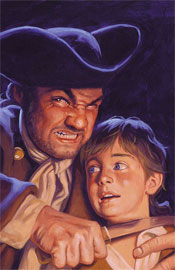
It’s a shame, then, that Mario Gully’s artwork and Roy Thomas’s storytelling miss that mark so entirely. If the interest is truly on interesting the youth with these stories, the issue should be bursting at the seams with life, personality and enthusiasm. I should be able to pick this up, open to the first page and immediately lose myself. Instead, those introductory panels are painfully stiff, extremely word-heavy and ultimately very dull. This looks like something my grandparents would be interested in reading, which is exactly the kind of atmosphere that’s keeping kids away from these stories in the first place.
Gully’s work is strict to a fault, like the stuff you’d expect to find in Prince Valiant with your Sunday paper. From my own experience as a child, Valiant was the one strip I would go out of my way to avoid every weekend in the funny pages, and I’m sure I can’t be the only one. Truthfully, I still avoid it today for the very same reasons. As the issue carries on the artwork loosens up a bit, but even at it’s best is nothing I’d consider to be up to the task of capturing the imagination of a younger audience.
The excess of captions and word balloons throughout only serve to further muddy an already-murky style of rendering. Every single panel has no less than two full sentences of narrative crammed in, which gives the entire issue a very weighty, overdone feel. Granted, the very idea of the story is that it’s adapted from the personal recollections of several participants. However, where that approach might be effective in the context of a novel, within the confines of a highly visual medium like a comic book, it’s ineffective. Although the story itself is filled with adventure and excitement, the excessively descriptive text turns the act of reading about it into a chore.
There’s a real lack of characterization in this tale, too, which is downright shocking considering the source material. The entire cast of villainous pirates functions as one single-minded unit, not a cluster of individuals. The level-headed crew of honest men are rigid, faceless and totally lacking in personality. Even Jack, the youthful face of the story, seems to exist only to react and never to participate. A handful of men lose their lives as the story progresses, but their deaths never mean anything because they were never proven to be valuable to the story. It’s like writer Roy Thomas cut out the meat of the original tale and retained the fat.
Regardless of the desired target market, this issue fails to connect. On a few rare occasions, the brilliance of the original story is given an opportunity to shine through, but those moments are few and far between. In the meantime, you’re left to wade through an excess of text describing the artwork it conceals, a lightweight cast and a dull, C-Level artist. Skip this and mourn the missed opportunities.
Overall Score: 1.5

No comments:
Post a Comment